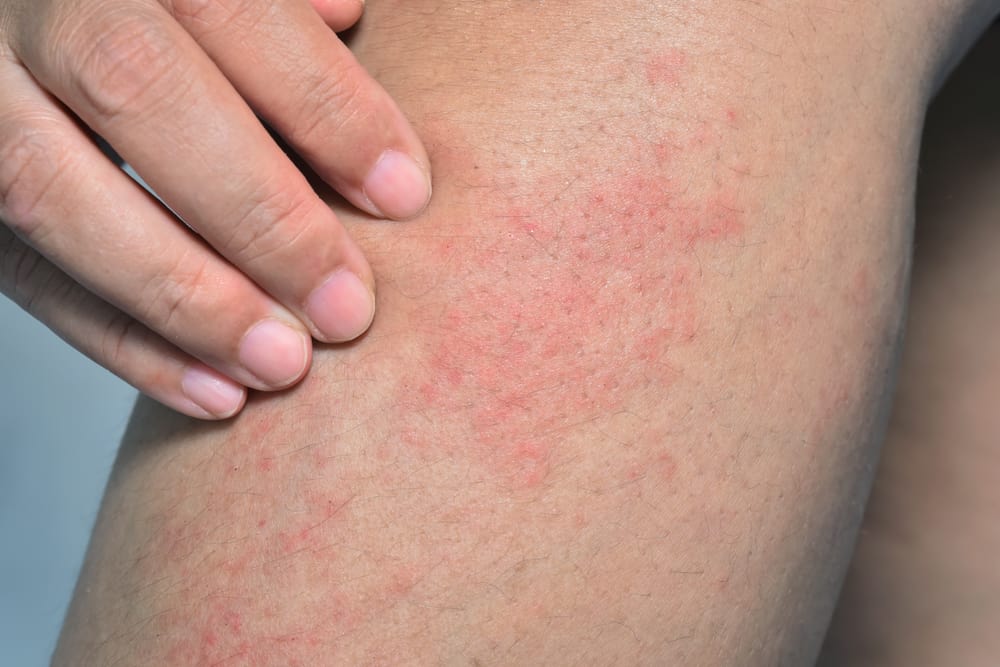Medically reviewed by Haley Andress, PA-C
Chlorinated pools do a good job of drying out your skin because chlorine strips away its natural oils. But if you develop a rash after swimming in a pool, you may be dealing with more than dry skin: It’s possible you have a chlorine rash. Any pool rash can take away a lot of the fun of going swimming, but there are ways to treat a chlorine rash and lower the risk of getting another one the next time you jump in.
Can you be allergic to chlorine?
A chlorine rash may look a lot like an allergic skin reaction, but there’s no such thing as a chlorine allergy. Rather, a chlorine rash is a type of irritant contact dermatitis—skin irritation caused by contact with a substance your skin is sensitive to.
Disinfectants such as chlorine are common triggers of irritant contact dermatitis. If you already have another form of dermatitis, such as eczema or seborrheic dermatitis, chlorine exposure can aggravate it.
In people who are frequently exposed to chlorine, it may play an indirect role in the development of respiratory allergies, such as asthma, by irritating the respiratory tract and making it more sensitive..
What does a chlorine rash look like?
A reaction to chlorine can cause redness, inflammation and bumps or patch-like lesions. The skin may be dry, scaly or crusty. Unfortunately, the rash doesn’t feel much better than it looks: Itching can be severe, and the skin may be tender. Symptoms usually develop a few hours after a swim in a chlorinated pool or a soak in a hot tub.
A chlorine rash is sometimes confused with swimmer’s itch (cercarial dermatitis), but swimmer’s itch is caused by tiny parasites found in freshwater and saltwater. Unless a pool is poorly maintained or the level of chlorine is too low, it’s unlikely you’ll run into any parasites.
Who gets chlorine rashes?
Anyone can be hypersensitive to chlorine, but it’s more likely to be an issue for people who spend a great deal of time in chlorinated pools, such as lifeguards and professional swimmers, or who work with chlorine. The risk is higher if you swim in heavily chlorinated pools, but even pools treated with lower levels of chlorine can cause a rash. That’s because chlorine creates an even harsher chemical called chloramine when it mixes with sweat or urine that may be in the pool or on your body.
You’re more vulnerable to chlorine rashes if you have a condition such as psoriasis or eczema that weakens the skin barrier. This outermost layer of skin normally protects against irritants and invaders. When it’s not functioning properly, it gives chlorine easy entry into the more delicate layers of skin beneath. (Using a barrier cream can help restore its function.)
Chlorine rash treatment
You can usually treat chlorine rash symptoms at home with over-the-counter creams. You will have to avoid chlorinated pools and hot tubs until the rash heals, but in most cases, it takes only a few days for symptoms to disappear. Do your best to avoid scratching the rash, which can make it painful and could result in scarring.
To get relief, dermatologists recommend using one or more of these:
CeraVe Itch Relieving Moisturizing Cream. Both a moisturizer and an itch-stopper, this cream contains 1% pramoxine hydrochloride for long-lasting relief of itching.
Benadryl Itch Stopping Cream. This cream contains 1% diphenhydramine hydrochloride, a topical painkiller that relieves itching. Oral Benadryl can help if you develop hives.
Hydrocortisone cream. These creams soothe redness, itching and inflammation. Don’t use one for more than a week or on your face unless your doctor advises you to.
A thick, fragrance-free body cream. Thick creams, such as Eucerin Original Healing Cream and CeraVe Moisturizing Cream, relieve dryness by locking moisture into the skin.
See a dermatologist if your symptoms are severe, are getting worse or persist despite at-home treatment. The doctor may prescribe a stronger steroid cream.
Ways to prevent chlorine rash
When you’re ready to get back in the pool, you can take some steps to avoid a chlorine rash or at least get a milder one.
Shower first to wash away any sweat and oil so it doesn’t interact with chlorine and form chloramine. Next, slather on petroleum jelly or a pre-swim lotion or chlorine rash cream to help reduce chlorine absorption. After your swim, shower immediately and use a body wash designed to remove chlorine, such as TRIHARD After Swim Body Wash. Apply a moisturizing cream, then change into loose, dry clothes.
Chlorine rashes caused by chlorine sensitivity are itchy and unpleasant. If the preventive steps above don’t help enough, consider switching to a saltwater pool (they require less chlorine) or even the ocean.
Written by Jessica Brown, a health and science writer/editor based in Nanuet, New York. She has written for Prevention magazine, jnj.com, BCRF.org, and many other outlets.
